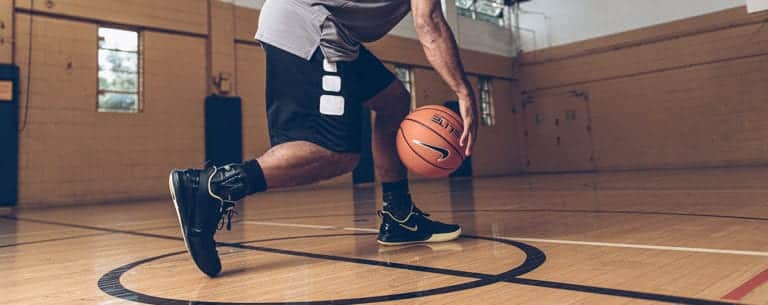
Short answer: Yes, in the majority of cases basketball players should wear an ankle brace.
Most people don’t realize that 42.9% of high school basketball players will injure their ankle during the course of their season, making the ankle the most common basketball injury location by far. Once a player suffers from an ankle injury, they are five times more likely to have reoccurring ankle injuries in the future. With the ankle injury rate so high in basketball it’s always wise to take precautions that can help prevent the ankle injury or lessen the severity should an injury occur.
Athletic trainers remedy basketball ankle injuries a number of ways, typically by taping and/or bracing their players after an injury as well as implementing an ankle strengthening program that utilizes stretches and balance exercises. Unfortunately, no amount of ankle strength can prevent an injury when a players comes down from a rebound and lands on another player’s foot. The only way to prevent these initial injuries, and reduce the risk of reoccurring injuries, is to wear an ankle brace designed specifically to work with the basketball player’s ankle, not against it, to protect the joint.
Before you start your basketball ankle brace search, it’s extremely important to understand the different ankle brace designs and how they may affect ankle strength, range of motion and performance.
Today you see a lot of basketball players wearing the lace-up style ankle supports primarily because they are low profile and upon initial impression they appear to provide good ankle support. A lace-up is basically a corset that restricts all ankle range of motion which is not ideal when you are trying to keep the ankle strong and maximize performance. Also, by restricting normal up and down ankle motion, the ankle works against the lace-up causing it to lose support rapidly. Lace-ups became popular as a replacement for the ankle tape job, which loses 70% of its effectiveness during the first 20 minutes of activity.
Rigid plastic ankle braces are another style of ankle brace. These types of ankle braces have a hinge and allow free up and down ankle motion to maximize performance and keep the muscles strong. They will provide much more ankle protection than the lace-up support because the brace moves with the ankle, not against it so the straps stay securely in place maintaining long last support. The downside is because these braces are rigid they can be uncomfortable and bulky which basketball players typically do not like.
A third style of ankle brace that offers the performance aspect of the hinged brace with the softness and low profile of the lace-up is the Ultra Zoom. The brace shell is made of an advanced flexible material called Performathane that uses body heat to custom-fit to the ankle. The hinged-cuff design allows full ankle range of motion and the cuff helps to restrict excessive ankle turning and twisting which causes both low and high ankle sprains.
Regardless of which type of ankle injury prevention methods you use as a basketball player, safely competing at a high level should always be one of your top priorities. If you’re a player with a history of basketball ankle injuries and want to speak with one of our certified athletic trainers about your specific situation, give us a call or send us an email and we’d be happy to help
SHARE WITH FRIENDS
RECENT POSTS
POST BY TOPIC
- Acute Ankle Injuries (5)
- Ankle Bracing (23)
- Ankle Injuries (13)
- Ankle Injury Prevention (15)
- Ankle Instability (6)
- Athletic Training (1)
- Basketball (9)
- Football (8)
- High Ankle Sprain (6)
- Hiking (4)
- injury (2)
- Mild/Moderate Ankle Injury (1)
- News (2)
- Osteoarthritis (3)
- Pickleball (7)
- Soccer (8)
- Sports (15)
- Tennis (8)
- Ultra 360 Lace-Up (3)
- Ultra CTS (8)
- Ultra High-5 (2)
- Ultra Zoom (14)
- Uncategorized (2)
- Volleyball (8)